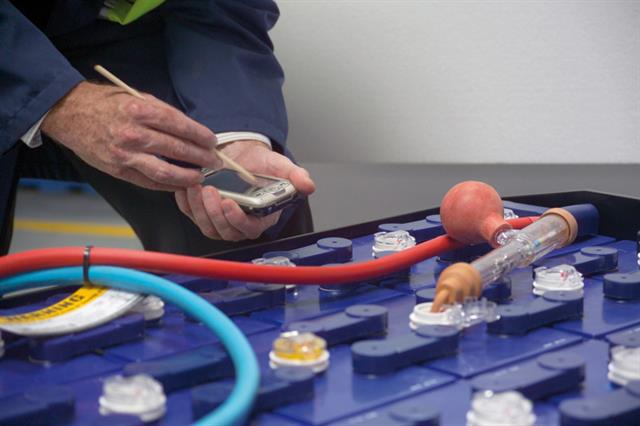 Batteries are getting smarter |
What is the current discussion around battery technology? Melissa Barnett looks at why lead-acid batteries are still popular, the current and emerging battery technology and the issue of battery recycling.
The global demand by consumers for rapid product delivery and the rise of automation and connectivity are factors which determine the market for batteries in the materials handling sector. In the US, the battery, charging and battery exchange markets expect to see growth of 5% to 2024 and an annual value of USD3 billion.
Lead-acid batteries dominated the market until the last decade, when the rapid growth of plug-in electric vehicles and automation demanded development of fast-charging, longer-lasting, emission-free battery power, prompting the rise of the lithium-ion battery. The subsequent rise of the IoT is pushing efficiency, requiring pieces of equipment to be able to speak with each other for data collection, management and maintenance.
Since 2015, a number of new industrial battery suppliers have entered the market with lithium-ion batteries as their sole product, and many of the long-standing leaders in the lead-acid battery market have introduced alternatives.
Forklift manufacturers on every continent now offer electric forklifts in a range of options as a response to the changing face of e-commerce. This, in turn, has an impact on battery technology and sales, and will continue to do so.
Lead-acid is still hereSince 2008, when the first lithium-ion powered forklift made its debut, the doomsayers have been predicting the demise of lead-acid batteries in electric forklifts, yet 12 years on, lead-acid batteries are still here and, for the time being, they are holding steady in a number of markets. The reasons for this are mainly cost and application.
"The acceptance of old or new battery technology is largely dependent on the cost saving achieved by the user," suggests Luke Low, marketing director for Regal Battery Marketing, based in Malaysia. "In the Asian market, lead-acid batteries will remain as the dominant choice for materials handling. This is due to its much cheaper cost, the fact that most forklifts are used for one-shift operations only, and the majority of customers do not own their own equipment. Furthermore, in Asia's hot and humid working environment, there is a risk of lithium batteries exploding. Disposal of these types of batteries is also a concern, because Malaysia, at this time, has no capability to recycle lithium batteries but we can and do recycle lead-acid batteries," says Low.
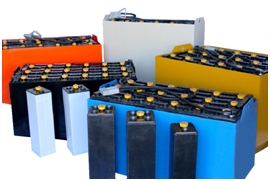 STB lead-acid forklift batteries |
Lisa Chen, sales manager for STB America, agrees that price is the main driver, but other considerations include the cost of having to modify existing equipment to accept lithium batteries or owning equipment that can't be modified. Chen adds that users of lead-acid batteries may also be loath to mothball their expensive charging infrastructure just yet.
"One of the most misunderstood thoughts in today's industry is that fast charging is the standard, when it is actually specific to application," suggests Paul Paciello, president of Helmar Performance Technology Parts. Paciello believes that the most important decision when choosing a battery and chargers is the environment it is being used in, and the reason why the majority of Helmar's customers opt for lead-acid batteries. "Most businesses work on a 9-5 work (day) and ... the most efficient charge is to plug in at the end of the day and come back to a fully charged battery at the start of the next work day. Avoiding premature failure is achieved best when batteries can charge at the slowest rate and do not get overcharged," Paciello explains. Helmar's PBM chargers are smart chargers which communicate with the battery to recognise the level of charge needed. Once it reaches 100%, the unit shuts off, so preserving battery life and mitigating premature cell failure.
A lead-acid forklift battery can constitute up to 30% of a new forklift's value and run for approximately 6,000 hours, so it makes economic sense to maximise the lifespan of an electric forklift with good battery management. Battery life can be affected by how a forklift is used, frequency of use and the weight of the load. Some simple steps can be taken to manage battery lifespan, including regular deep-cycle charging, ensuring the battery doesn't freeze or overheat, topping up fluids, avoiding flattening the battery and managing the build-up of lead sulphate.
 |
"The most significant problem with lead batteries are sulfation and the degradation of lead plates," says Dušan Uhrik, spokesman for Slovakian manufacturer of PowerBatt, an organic liquid battery additive. To extend the life of a lead-acid battery, PowerBatt claims to reverse battery sulfation, increase porosity and strengthen active mass while eliminating 'Brown Mud', the sediment that builds up at the bottom of the battery case. "By reversing the damage, a battery destined for the recycling bin is returned to 'like-new condition', prolonging battery life and performance," says Uhrik.
Lithium-ion, the growing battery market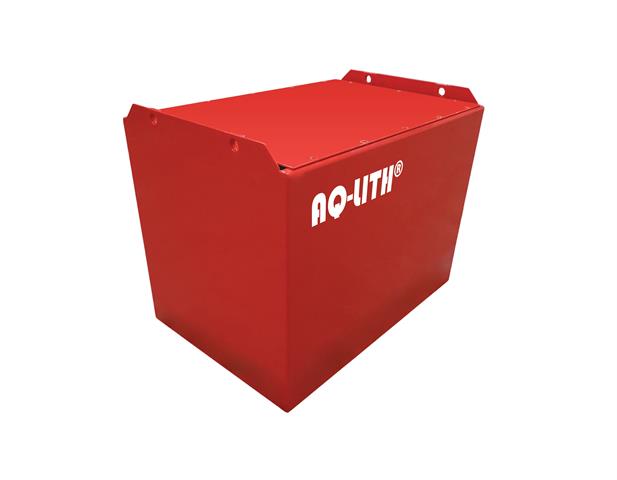 Battery Supplies AQ-Lith lithium-ion battery |
Improved productivity and efficiency are often the drivers for new technology and while lithium-ion batteries after a decade on the market can hardly be said to be new technology, the reasons for taking up the technology remain constant. In the US, the adoption rate for lithium-ion technology in the materials handling market in 2018 was 2.5%. The most common complaint about lithium batteries is the high initial cost but, as Koen Bilcke , co-ordinator for Belgium's Battery Supplies Technology Centre, explains, "While the investment of a lithium-ion battery is more than double compared to other traction batteries, if you take into consideration the total energy stored in the battery over its lifetime, the energy throughput is more than four times higher. The energy density of lithium-ion is very high. With restricted dimensions, you can easily increase the capacity and autonomy of your application. For example, due to the low-emission zones in the Netherlands, we see an increased need for electrical cranes in historical town centres. A lead-acid battery can't be used in this application, as it doesn't have sufficient capacity for the job. Lithium-ion batteries have such a high energy density that they can increase the autonomy of the crane for the entire day," says Bilcke .
Robert O'Dette, executive vice-president and COO of Revel Industrial Batteries, believes the perfect scenario is to achieve efficiency and productivity while reducing overall costs and believes lithium battery technology can achieve all three critical needs. "Lithium batteries can produce two to three times more duty cycles than lead-acid batteries. They don't require battery changes and, over the course of a work shift, they perform more consistently because there is no voltage drop, especially in high and heavy load applications. As well, lithium batteries can be recharged in an hour or less, depending on the depth of charge. In a two- to three-shift application, one lithium battery can take the place of two or three lead-acid batteries. Charging management and battery performance can all be managed through battery telematics. What this boils down to is a better return on investment," says O'Dette. Safety, environmental impact and ease of use are also areas customers look to for improvement, O'Dette adds. "The driving force behind our design is safety. Revel chose a prismatic cell design, which is the safest cell for use in forklift applications. Our chemistry, lithium iron manganese phosphate (LiFeMnPO4),is the most stable chemistry for forklift use," says O'Dette.
Whenever a new technology is released onto the market, it takes time and a steady program of education to allay concerns of potential customers. Fear and reason, says Thomas Duck, vice-president and general manager of US forklift dealer Tri-Lift NC, are reasons that customers are reluctant to take up new battery technology. "The main thing we have done is give a thorough presentation of the product, along with cost of operation analysis, usually 12 to 24 months ROI, and a demonstration of the product, so the customer can see how easy the BYD battery is to charge and maintain. Most customers convert to lithium-ion batteries because of the costs related to IC forklifts, the new standards required for engines, high maintenance costs and high fuel costs," says Duck.
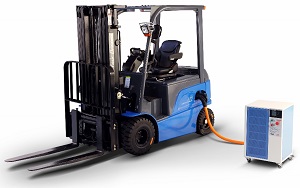 BYD lithium-ion powered electric forklift |
One of Tri-lift NC's customers, a food manufacturing plant and warehouse, currently has 24 BYD lithium-ion phosphate battery powered forklifts in operation and another 16 on order. "The customer operated both IC and battery-driven forklifts. Since changing to lithium battery power, his efficiency has increased, with drivers spending more time moving product and less time changing fuel tanks, checking oil or dealing with changing or watering batteries. The customer actually reduced the size of his fleet by 16 forklifts," says Duck.
Bi Guozhong, forklift division general manager for Chinese manufacturer BYD, believes technical innovation will be what will appeal to lithium-ion battery users and converts. "Innovation will contribute to the result of doing more with less for customers. Customers mostly want what is suitable and can solve the problem, while creating value for them," Guozhong believes. BYD was one of the early innovators of lithium-ion technology and has been instrumental in the development of lithium-ion phosphate batteries as well as designing one of the first forklifts to use lithium battery technology. BYD's ECB18C won the 2016 IFOY award for counterbalance truck up to 3.5T. The ECB18C is an 80 v lithium-ion stacker and in the judges' opinion, the forklift solved one of the biggest problems of electric forklifts - operating longevity, as the ECB18C, with its lithium-ion phosphate battery, can be recharged extremely fast, as often as needed and without memory effect, which means it can handle a three-shift duty without stopping.
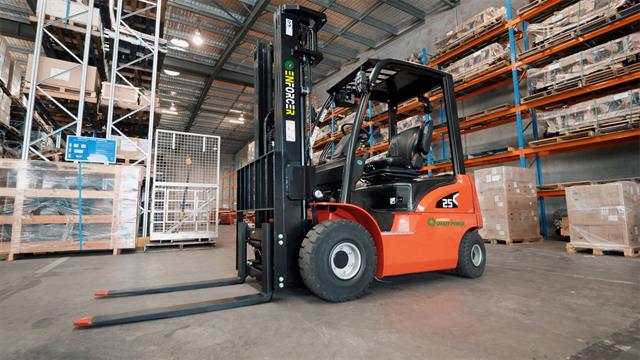 Fork Force all-weather Enforcer electric forklift |
Adrian Martin, general manager, quality and product support for Australian-based dealer Fork Force, says that lithium-ion batteries bridge the gap between internal combustion engine forklifts and electric, modified to meet European standards, but because of the reduction in power to meet emission requirements are unacceptable to many operators. "Lithium battery forklifts have shorter charge times, comparable cost of ownership and a safer, cleaner, longer-lasting operation," says Martin. He adds that the ease of charging and the elimination of daily battery maintenance has significant occupational health and safety advantages.
RecyclingThere are a number of reasons that make lithium-ion batteries a winner in the energy technology stakes but the ability to recycle them isn't one. The majority of lithium-ion batteries, including the lithium phosphate batteries preferred by the materials handling sector, are a challenging commodity when It comes to recycling. A recent Australian CSIRO (Commonwealth Science and Industrial Research Organisation) report on lithium-ion recycling stated that only 2% of Australia's annual 3,300 T of lithium-ion battery waste is recycled, and while this is made up mainly of domestic rather than industrial lithium-ion waste, industry does contribute. Current figures for Europe and the US are not much higher - less than 5%. By comparison, the report also stated that of the 150,000 T of lead-acid batteries sold in 2010, 98% were recycled. The report went on to observe that as electric vehicles become increasingly common, this problem is likely to be compounded. Industry analysts predict that this year, China alone will generate 500,000 T of used lithium-ion batteries and by 2030, the worldwide number will hit 2 million T per year.
The CSIRO research team leader Anand Bhatt explained in a recent interview with digital magazine
Future Power Technology that lead-acid battery technologies are already considered to be 'green' technology because they are actively collected and recycled at a high percentage rate, something that does not happen with lithium-ion batteries. Bhatt went on to explain that recycling lithium-ion batteries is focused on the recovery of selected high-value materials. One of the issues is that battery advancements can reduce the economics of recycling. For example, the lithium iron phosphate battery contains no high-value cobalt, which is one of the key economic drivers for recycling. Lithium battery technology is investigating lithium sulfur as a key component in emerging lithium battery technology, particularly for electric vehicles, due to its higher energy storage capability. However, lithium sulphur is unsuitable for current recycling plants, it also has little economic value, and the lithium metal in these batteries can cause problems when exposed to air and moisture.
When lithium-ion batteries are recycled, they undergo a high temperature smelting process. The operation is carried out in purpose-built buildings, which are expensive to build and to operate and require particular equipment to deal with the toxic emissions generated by the smelting process. Despite the cost, the current generation of recycling plants is incapable of extracting all of the lithium-ion battery materials. Lithium-ion batteries also have a complicated structure; in contrast, lead-acid batteries are easily disassembled. The lead, which accounts for roughly 60% of a battery's weight, can be separated quickly from the other components, resulting in nearly 100% of the lead being recycled.
Limited lithium battery recycling exists in most countries and the CSIRO report suggests that if industry and new technology can work together, effective recycling can be established and provide a value-added input to resource production. The key, Bhatt's team says, is to divert batteries from land-fill - to do this requires a combined regulatory approach, new science solutions and investment - and consumer education.
Where to for lithium?Not only do lithium-ion batteries need to step up to their "green credentials" with better recycling options, but for some experts, like Graham Conway, principal engineer at US research and development organisation Southwest Research Institute, the idea of 'Zero Emissions' is misleading. Conway says emissions are currently measured from the tailpipe - no tailpipe, no emissions - but they should, in fact, be measured from cradle to grave, measuring emissions generated by production of the vehicle, mining of the raw-earth minerals required for lithium-ion batteries and the energy heavy production of the batteries themselves. Conway believes that the future is energy from bio-fuels and renewables, and for larger equipment, hydrogen fuel cells. But the best technology would be hybridisation - when battery power and internal combustion engines work together to unlock maximum efficiency from internal combustion engines.
O'Dette agrees that fuel cell technology may have a future: "Fuel cell technology has made some great advances in the last 10 years and it does make sense in extremely large applications," he says, but what excites him more is the idea of inductive charging, "where operators will simply park the forklift next to an induction pad for charging - no plugs, no cables," muses O'Dette.
Regal's Low says that new technologies that have caught his eye include graphene and solid-state batteries, but he believes that these will not be mainstream unless they are commercially viable.
Despite the talk of alternatives, battery power is still the most viable technology, particularly with R&D of electrode materials. Experts predict that the capacity of lithium-ion batteries will increase by up to 40% with more development. The advances are made possible by anodes that increase their capacity by enriching the material with silicon and high-voltage stable electrolytes that significantly improve performance of the cathodes.
Lithium-ion battery technology will undoubtedly continue to improve and develop the advantages of high energy density, performance, efficiency and ease of use which have made them already so popular. But, until lithium-ion batteries cost close to lead-acid battery prices, lead-acid will continue to be the preferred choice in a number of materials handling sectors.
Additional information and a special 'THANK YOU' to our contributors:The battery charger industry is changing. You can now buy DIRECT!
Helmar Parts: website------------------------------------
Revel Lithium Batteries Powering the Future
Revel Industrial Batteries: website------------------------------------
Handle materials cost effectively & with more efficiency like never before!
Fork Force Australia: website------------------------------------
BYD Electric Forklift Solutions from Tri-Lift NC
Tri-Lift NC: website------------------------------------
Your Lithium Ion solutions from Battery Supplies
Battery Supplies N.V.: website------------------------------------
PowerBatt - battery life extender
PowerBatt: website------------------------------------
STB America revolutionizes the forklift battery
STB America: website------------------------------------
BYD Lithium Forklifts from eForklift.com.au
eforklifts: website------------------------------------
Regal Battery